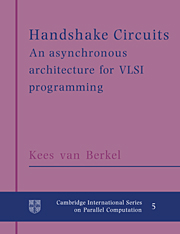Book contents
- Frontmatter
- Contents
- Foreword
- Preface
- 0 Introduction
- 1 Introduction to Tangram and handshake circuits
- 2 Examples of VLSI programs
- 3 Handshake processes
- 4 Handshake circuits
- 5 Sequential handshake processes
- 6 Tangram
- 7 Tangram → handshake circuits
- 8 Handshake circuits → VLSI circuits
- 9 In practice
- A Delay insensitivity
- B Failure semantics
- Bibliography
- Glossary of symbols
- Index
B - Failure semantics
Published online by Cambridge University Press: 14 January 2010
- Frontmatter
- Contents
- Foreword
- Preface
- 0 Introduction
- 1 Introduction to Tangram and handshake circuits
- 2 Examples of VLSI programs
- 3 Handshake processes
- 4 Handshake circuits
- 5 Sequential handshake processes
- 6 Tangram
- 7 Tangram → handshake circuits
- 8 Handshake circuits → VLSI circuits
- 9 In practice
- A Delay insensitivity
- B Failure semantics
- Bibliography
- Glossary of symbols
- Index
Summary
In Chapter 6 we have developed a handshake semantics for Tangram. An alternative semantics for Tangram can be based on failure processes [BHR84]. Failure processes form the underlying model of CSP [Hoa85], and are the basis for a well-established theory for CSP, including a powerful calculus [RH88].
The availability of two distinct semantics for the same program notation suggests several questions, including:
0. Is the handshake-process semantics consistent with the failure semantics? If so, in what sense?
1. Can VLSI programmers use calculi that are based on failure semantics?
The last question is of obvious practical significance.
This appendix starts with a description of failure processes. By means of a simple example it is shown that an embedding of failure processes into all-active handshake processes does not exist. By choosing a more subtle link between handshake semantics and failure semantics, we arrive at positive answers to the above questions.
Failure processes
This subsection describes a process model based on failures. The description below is rather concise; for a more extensive treatment the reader is referred to [BHR84], [BR85] and [Hoa85].
An alphabet structure defines an alphabet as a set of communications.
Definition B.O (alphabet of an alphabet structure)
Let A be an alphabet structure.
A communication of A is a pair a: v, such that a ∈ cA and v ∈ TA.a.
The alphabet of A is the set of all communications of A and is denoted by aA.
- Type
- Chapter
- Information
- Handshake CircuitsAn Asynchronous Architecture for VLSI Programming, pp. 201 - 208Publisher: Cambridge University PressPrint publication year: 1994



